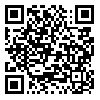Volume 13, Issue 3 (7-2009)
IBJ 2009, 13(3): 161-168 |
Back to browse issues page
Download citation:
BibTeX | RIS | EndNote | Medlars | ProCite | Reference Manager | RefWorks
Send citation to:



BibTeX | RIS | EndNote | Medlars | ProCite | Reference Manager | RefWorks
Send citation to:
Kazemi B, Seyed N, Moslemi E, Bandehpour M, Bikhof Torbati M, Saadat N, et al . Insulin Receptor Gene Mutations in Iranian Patients with Type II Diabetes Mellitus. IBJ 2009; 13 (3) :161-168
URL: http://ibj.pasteur.ac.ir/article-1-68-en.html
URL: http://ibj.pasteur.ac.ir/article-1-68-en.html
Bahram Kazemi * 
 , Negar Seyed
, Negar Seyed 
 , Elham Moslemi
, Elham Moslemi 
 , Mojgan Bandehpour
, Mojgan Bandehpour 
 , Maryam Bikhof Torbati
, Maryam Bikhof Torbati 
 , Navid Saadat
, Navid Saadat 
 , Akram Eidi
, Akram Eidi 
 , Elham Ghayoor
, Elham Ghayoor 
 , Fereydoun Azizi
, Fereydoun Azizi 


 , Negar Seyed
, Negar Seyed 
 , Elham Moslemi
, Elham Moslemi 
 , Mojgan Bandehpour
, Mojgan Bandehpour 
 , Maryam Bikhof Torbati
, Maryam Bikhof Torbati 
 , Navid Saadat
, Navid Saadat 
 , Akram Eidi
, Akram Eidi 
 , Elham Ghayoor
, Elham Ghayoor 
 , Fereydoun Azizi
, Fereydoun Azizi 

Abstract:
Background: Patients with diabetes mellitus type II suffer from hyperglycemia because they are not able to use the insulin that they produce, often due to inadequate function of insulin receptors. There are some evidences that this deficiency is inherited in a dominant autosomal manner and leads to the malfunction of the pancreatic beta cells resulting in insulin excretion disorders. In this study, we sought to identify mutations in the insulin receptor (INSR) gene, which can cause insulin resistance in type II diabetic patients. Methods: DNA was extracted from peripheral blood cells of the patients (n = 128) diagnosed with type II diabetes. All 22 exons of the INSR gene of the patients were analyzed for mutations running PCR, conformation-sensitive gel electrophoresis and DNA sequencing, consecutively. Results: Approximately 26% of the patients had genetic mutations however, most of them were not reported. These mutations include exon 2 (His171Asn, Ile172Ser, Cys196Ser and Ser210Arg), exon 3 (Gly227Asp and Gly232Ser), exon 8 (Thr543Ser), exon 9 (a heterozygote was observed with no change in phenylalanine at position 669), exon 13 (two heterozygotes: Arg890Pro with Asn865 remaining unchanged), exon 14 (Ala906Gly and Pro918Trp with Arg902 unchanged), exon 17 (Val1086Glu) and exon 19 (His1157Gln with Thr1172 unchanged). Conclusion: The lack of similar mutation records in literature and genetic data banks may suggest a geographic pattern for these INSR gene variants in our population.
Keywords: Diabetes type II, Insulin resistance, PCR, Conformation-sensitive gel electrophoresis (CSGE), Iran
Type of Study: Full Length/Original Article |
Subject:
Related Fields
| Rights and permissions | |
 |
This work is licensed under a Creative Commons Attribution-NonCommercial 4.0 International License. |






.png)
